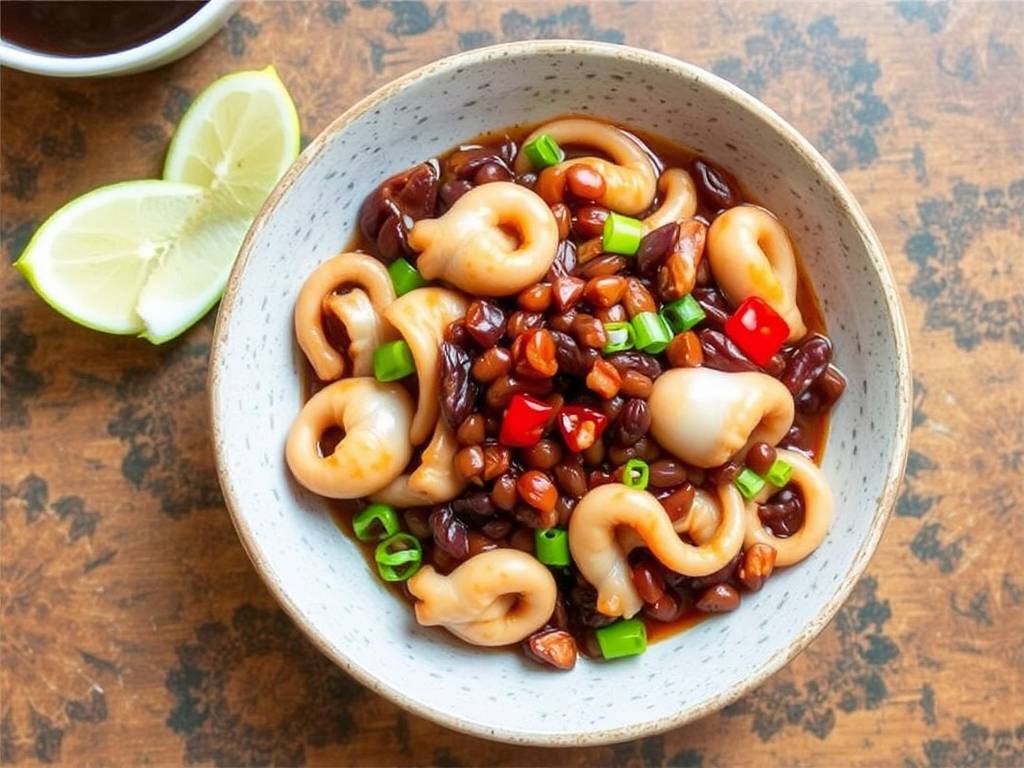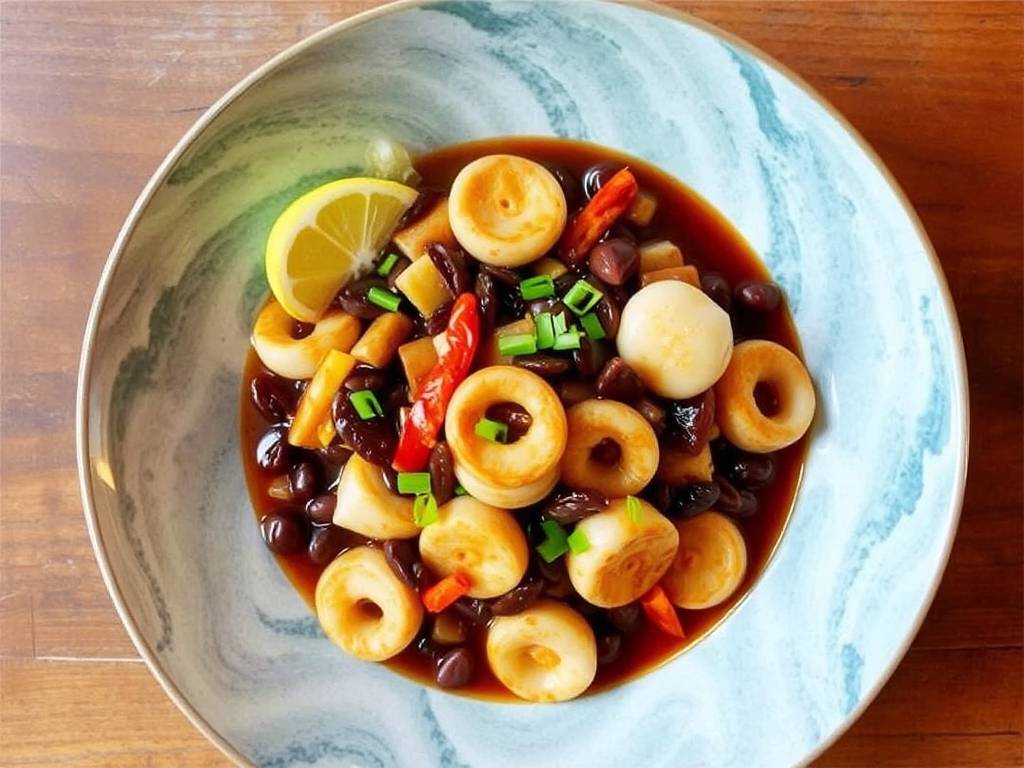The Art of Cooking Squid with Black Bean and Chili Sauce: A Symphony of Savory Heat
The allure of perfectly cooked squid is undeniable. When tender, it offers a delicate, slightly sweet canvas, a blank slate eagerly awaiting bold flavors. And few combinations are as profoundly satisfying and complex as the savory, fermented punch of black beans paired with the bright, penetrating heat of chili. Cooking squid with black bean and chili sauce is not merely a recipe; it is an exercise in balancing textures and intense umami flavors, resulting in a dish that is both rustic and sophisticated. This guide will walk you through the entire process, from selecting your ingredients to mastering the high-heat stir-fry technique that is the heart of this classic preparation.
Understanding Your Core Ingredients

The success of this dish hinges on the quality and preparation of three key components: the squid, the black beans, and the chili.
-
The Squid: Freshness is paramount. Look for squid with firm, glossy flesh, a clean sea-breeze scent, and eyes that are clear, not cloudy. Both the body (tube) and tentacles are used. When cleaning, remove the transparent quill (pen) from inside the body, the innards, and the purplish skin. A crucial step for tender squid is scoring the interior of the body in a cross-hatch pattern. This not only creates an attractive "pinecone" effect when cooked but, more importantly, allows for quick, even heat penetration, preventing the squid from becoming tough and rubbery. The tentacles can be left whole or separated.
-
Fermented Black Beans (Douchi): These are not the black beans used in Latin American cuisine. Fermented black beans are small, dried, and salted soybeans that have been fermented, resulting in an intensely savory, salty, and slightly funky flavor—a cornerstone of umami in many Chinese dishes. They are typically sold in plastic bags or jars. Before use, they should be rinsed briefly to remove excess salt and then roughly chopped to release their deep, aromatic oils. Do not over-rinse, as you want to preserve their potent character.
-
The Chili Element: This can be adapted to your heat preference. For a vibrant, fresh heat, use red or green chili peppers like serrano or Fresno, sliced thinly. For a deeper, smokier heat and a brilliant red color, dried red chilies (such as arbol or Sichuan chilies) are excellent. They can be used whole or halved, with seeds removed for less heat. The third option is a prepared chili sauce or paste, like Sambal Oelek or a garlic-chili paste, which adds both heat and a smoother texture to the final sauce.
Crafting the Flavor Foundation: The Aromatics and Sauce
A great stir-fry is built in layers. Before the squid even hits the wok, you must prepare the supporting cast that will build the dish's aromatic depth.
- Aromatics: Garlic and ginger are non-negotiable. Finely mince them so they disperse their fragrance evenly throughout the dish. Scallions are also essential, but use them in two parts: the white bottoms are added with the garlic and ginger as an aromatic base, while the green tops are saved for a fresh garnish at the end.
- The Sauce Mixture: To avoid a last-minute scramble during the high-speed cooking process, always mix your sauce in a small bowl beforehand. This ensures a consistent flavor and a glossy, well-coated finish. A typical sauce for this dish might include:
- Light Soy Sauce: For saltiness and depth.
- Shaoxing Wine: A Chinese rice wine that adds a subtle sweetness and removes any fishy notes from the seafood.
- Oyster Sauce: For a rich, sweet-savory backbone.
- A touch of Sugar: To balance the saltiness.
- Cornstarch: A small amount is crucial. It slightly thickens the sauce, allowing it to cling beautifully to the squid.
- Water or Stock: To create the right volume and consistency.
The Cooking Process: A Dance with High Heat

Stir-frying is a fast and furious technique. Have all your ingredients prepped, measured, and within arm's reach of the stove (a practice known as mise en place). A wok is ideal for its shape and heat distribution, but a large, heavy-bottomed skillet will also work.
Step 1: The Quick Blanch (Velveting) This is the secret to guaranteeing tender squid. Bring a pot of water to a rolling boil. Have a bowl of ice water ready nearby. Briefly submerge the scored squid tubes and tentacles in the boiling water for just 20-30 seconds—until they curl up and turn opaque. Immediately plunge them into the ice water to stop the cooking process. This step sets the protein, ensuring it won't release too much water in the wok and become tough. Drain thoroughly.
Step 2: Building the Aromatic Base Heat your wok over high heat until it just begins to smoke. Add a neutral oil with a high smoke point, like peanut or canola oil, and swirl it to coat the surface. Reduce the heat to medium-high and add the chopped fermented black beans. Stir-fry for about 30 seconds until they become incredibly fragrant. Then, add the garlic, ginger, and white parts of the scallions, along with your chilies (if using dried or fresh). Stir-fry for another 30-60 seconds, taking care not to burn the garlic. The kitchen should be filled with an irresistible aroma.
Step 3: The Main Event Increase the heat back to high. Add the blanched and drained squid to the wok. Toss and stir vigorously for about one minute, allowing the squid to sear slightly and absorb the flavors of the aromatic base.
Step 4: Bringing it all Together Give your pre-mixed sauce a final stir (the cornstarch may have settled) and pour it in a circular motion around the sides of the wok. The liquid will instantly sizzle and thicken. Toss everything together quickly and efficiently for another minute until the squid is evenly coated in a glossy, dark sauce. The entire stir-frying process should take only 2-3 minutes.
Step 5: The Final Touch Remove the wok from the heat. Stir in the green parts of the scallions. A final drizzle of a small amount of toasted sesame oil will add a wonderful nutty fragrance.
Serving Suggestions
This robust and flavorful dish is best served immediately over a bed of steamed jasmine rice, which perfectly soaks up the savory sauce. It can also be part of a larger meal with other dishes, such as simple steamed greens like gai lan (Chinese broccoli) or bok choy to provide a refreshing contrast.
Variations and Customizations
The beauty of this recipe lies in its adaptability.
- Vegetable Add-Ins: Add texture and color by stir-frying vegetables before the squid. Sliced bell peppers, onions, or snow peas are excellent choices. Stir-fry them after the aromatics until crisp-tender, then remove, proceed with the squid, and add them back with the sauce.
- Protein Swap: While squid is the star, the black bean and chili sauce is fantastic with other proteins like shrimp, scallops, chicken, or firm tofu.
- Regional Twists: For a taste of Sichuan, add a teaspoon of Sichuan peppercorns with the dried chilies for their characteristic numbing mala sensation. A spoonful of doubanjiang (fermented broad bean paste) will add even more depth and heat.
Cooking squid with black bean and chili sauce is a rewarding culinary adventure. It teaches the importance of preparation, the mastery of high-heat cooking, and the art of balancing powerful flavors. By understanding the role of each ingredient and respecting the technique, you can transform simple components into a restaurant-quality dish that sings with savory, spicy, and umami-rich harmony. So, gather your ingredients, fire up your wok, and prepare to create a truly unforgettable meal.






发表评论